Aphids, minute yet formidable pests, are the bane of plant enthusiasts worldwide. These diminutive insects, typically just a few millimeters long, can inflict substantial damage on indoor plants. A report from the Journal of Economic Entomology reveals that there are more than 4,000 known aphid species, each showcasing an array of colors and each with a taste for different types of plants.
Fueled by a rapid reproduction rate, aphids can launch a full-scale infestation within a matter of days. They pierce plant tissues with their needle-like mouthparts to extract sap, depriving the plant of vital nutrients. Over time, this leads to wilting, yellowing, and potentially the demise of the plant.
Whether you’re a novice indoor gardener or a seasoned green thumb, a comprehensive understanding of aphids—their lifecycle, the signs of their presence, and effective strategies for their removal and prevention—is crucial. Let’s take a journey to unpack the aphid problem and arm you with the knowledge to protect your verdant oasis.
What are Aphids and Why are They a Problem for Indoor Plants?
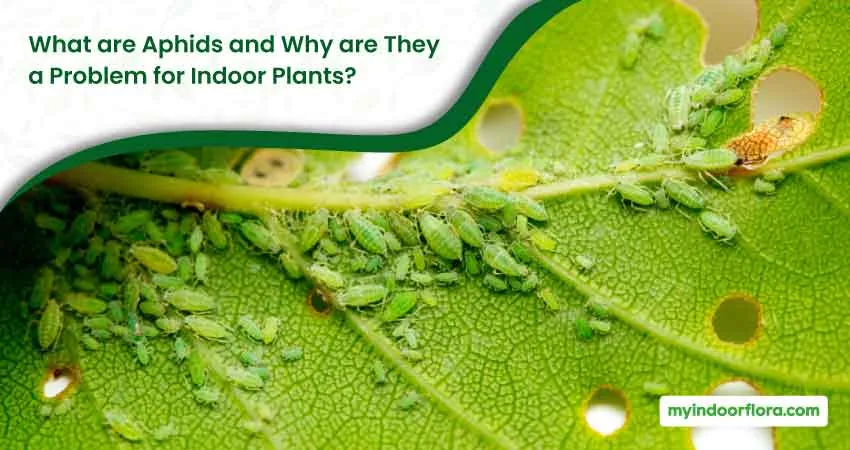
Aphids, scientifically known as Aphidoidea, are tiny insects notorious for sucking the sap out of your plants. Shaped like pears, they vary in color from green to black and are often found clinging to the undersides of leaves. As they feast on your plants, they excrete a sticky substance known as honeydew, which can invite fungal diseases and mar the aesthetics of your plant with its unsightly, shiny coat.
The ensuing damage causes leaves to yellow and curl, stunt plant growth, and potentially lead to the plant’s death. Aphids reproduce at a prodigious rate, laying hundreds of eggs, creating an infestation in no time.
How Do Aphids Infest Indoor Plants?
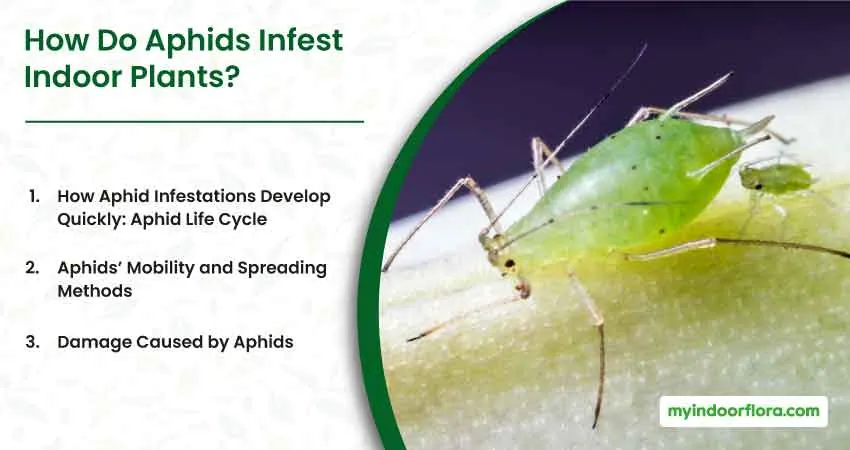
How these diminutive destroyers reach your indoor plants can be quite puzzling. Some aphids ride the wind to enter through open windows or doors. Others hitch a ride on your clothing or the new plants you bring home.
Plants stressed due to inadequate light or over-fertilization are more susceptible to aphid infestations, thus underlining the importance of proper plant care.
How Aphid Infestations Develop Quickly: Aphid Life Cycle
The secret to aphids’ swift infestation lies in their reproductive prowess. Unlike other pests that lay eggs, most species of aphids give birth to live offspring, known as nymphs. These nymphs reach maturity in just one week and then begin to reproduce themselves. Within a month, a single aphid can potentially generate hundreds of offspring, leading to an exponential rise in population and rapid plant damage.
Aphids’ Mobility and Spreading Methods
Aphids have several ways of getting around. While most aphids are wingless, certain environmental stresses (like overcrowding or food shortage) can cause them to develop wings and fly to new plants. They can also be carried by the wind or inadvertently transported on clothing, pets, or other insects.
Damage Caused by Aphids
The harm aphids cause is twofold. First, they directly damage the plant by sucking sap, primarily from new growth where the plant’s tissues are tender and rich in nutrients.
1. Sucking Sap from New Growth
Aphids prefer new growth because of its high nutritional content. As they suck the sap, they rob the plant of vital nutrients needed for growth and development, leading to a weakened plant that’s more susceptible to disease.
2. Crinkled or Stunted Foliage
A common sign of aphid damage is crinkled or stunted foliage. The loss of sap causes leaves to curl and lose their normal shape, reducing the plant’s ability to photosynthesize and thereby stunting its growth.
3. Aphids Clustering at the Growth End
Aphids love to cluster at the growth ends of plants, where the most nutritious sap is found. Large clusters of aphids can be easily spotted, often appearing as a fuzzy, moving mass on stems and leaves.
4. Leaf Drop due to Severe Infestation
In severe infestations, the plant may begin to drop leaves prematurely as a stress response. This can result in the death of the plant if left unchecked.
5. Sooty Mold and Fungus Caused by Aphid Honeydew
The second form of aphid damage comes from their excretion, known as honeydew. This sticky substance coats the plant’s surfaces and can lead to the growth of a black, sooty mold. Not only does this mold mar the plant’s appearance, but it also reduces photosynthesis and can attract other pests.
How Can You Identify an Aphid Infestation on Your Indoor Plants?
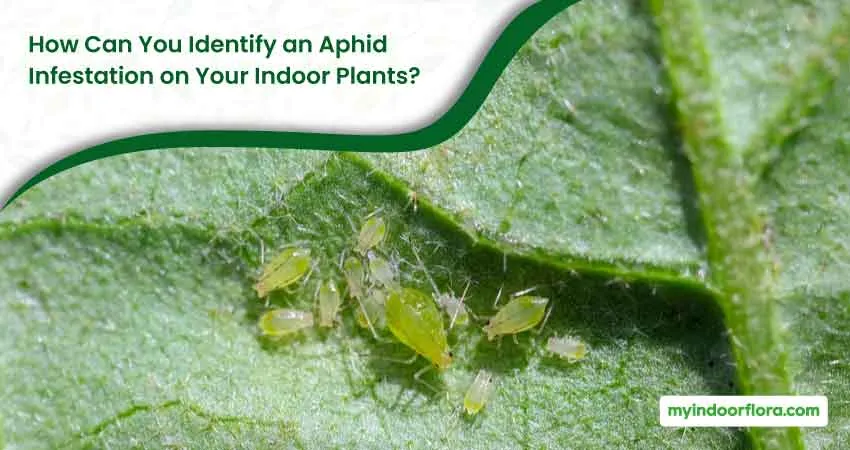
Early detection of an aphid infestation is paramount to controlling the problem. Here are some signs to look out for:
- Check the undersides of leaves and the joints of leaves and stems for clusters of tiny insects.
- Look out for a shiny, sticky substance on the leaves or floor beneath the plant. This is the honeydew aphids excrete.
- Black, sooty mold can grow on the honeydew, a further sign of infestation.
- Misshapen, yellowing, or curling leaves can indicate aphid activity.
- Plants may have stunted growth and show a general decline in health.
How to Conduct a Thorough Aphid Inspection?
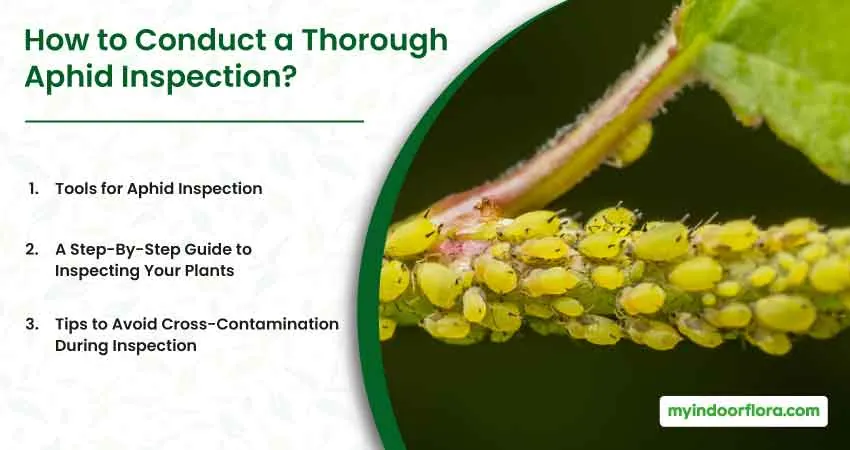
Aphid inspections require attention to detail and a methodical approach. The following steps can help you conduct a thorough examination.
Tools for Aphid Inspection
A magnifying glass can be extremely useful in detecting aphids, especially the smaller nymphs. Handheld models are generally sufficient, though some indoor gardeners prefer models with built-in lights for improved visibility.
A Step-By-Step Guide to Inspecting Your Plants
- Begin by visually inspecting your plant. Look for signs of aphid damage, such as curling or yellowing leaves, a sticky residue, or black sooty mold.
- Check the undersides of leaves and the junctions where leaves meet the stem. These are common aphid hiding spots.
- Use a magnifying glass to look for aphids or their nymphs. Remember, they can range in color from green to black to pink, so don’t just look for one color.
- If you suspect an infestation but can’t find any aphids, try shaking the plant gently over a sheet of white paper. Aphids or their nymphs may fall onto the paper, where they’ll be easier to see.
Tips to Avoid Cross-Contamination During Inspection
Cross-contamination can quickly spread an aphid infestation from one plant to another. Clean your hands and tools thoroughly between inspecting different plants, and consider isolating infested plants until the issue has been resolved.
How Can You Prevent Aphids from Attacking Your Indoor Plants?
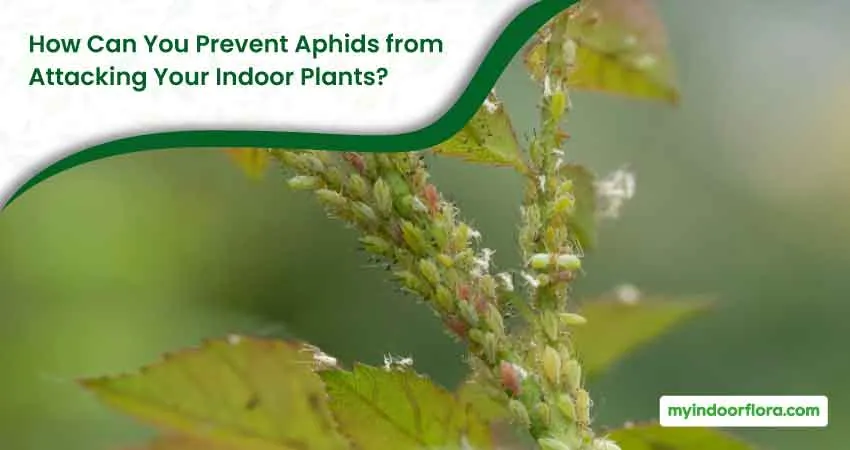
Prevention is always better than cure. Reducing the risk of aphid infestations can save you the time and effort of having to deal with a full-blown attack later. Here are some prevention tips:
- Regularly inspect new plants before bringing them indoors.
- Maintain plant health with proper light, water, and nutrient management.
- Promote good airflow around plants to discourage aphid settlement.
- Use sticky yellow traps to catch flying aphids.
The next section explores different methods to handle an infestation if, despite your best efforts, aphids still manage to infiltrate your indoor garden.
Methods for Controlling Aphids on Indoor House Plants
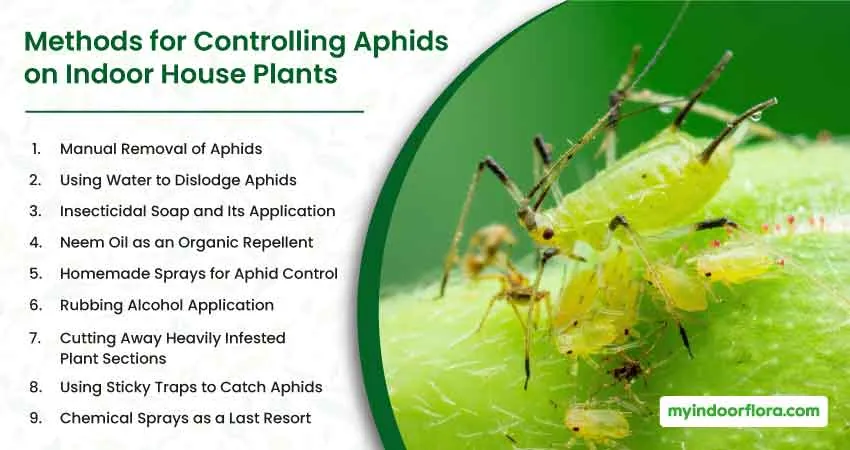
Despite our best prevention efforts, aphids may still find their way to our beloved indoor plants. When an infestation occurs, swift action is essential to protect your plants. Here are several tried-and-tested methods to control aphids on indoor house plants.
1. Manual Removal of Aphids
Perhaps the most straightforward method is manual removal. If you notice just a few aphids on your plant, you can squash them between your fingers. For those who find this method distasteful, a pair of tweezers can do the job just as well. This method is particularly effective for larger species of aphids that are easy to see and grasp.
2. Using Water to Dislodge Aphids
Another simple yet effective method is using a strong stream of water to dislodge aphids from the plant. This can be achieved with a regular kitchen sprayer or, for more stubborn aphids, a higher pressure garden hose. After spraying, aphids often struggle to return to the plant, reducing the population significantly. Be careful not to damage delicate plants with a forceful stream of water.
3. Insecticidal Soap and Its Application
Insecticidal soaps are a safe and effective way to control aphids. They work by breaking down the insect’s protective cuticle, leading to dehydration and death. To use, dilute the soap as directed on the packaging, then spray it directly onto the aphids. Make sure to cover the underside of leaves as well, where aphids often hide.
4. Neem Oil as an Organic Repellent
Derived from the seeds of the Neem tree, neem oil is a popular organic pesticide. It works by disrupting the hormones of insects, hindering their feeding, and growth. To use, mix a few drops of neem oil with water and spray it directly onto the aphids. It also has the added benefit of repelling other pests and fungal diseases.
5. Homemade Sprays for Aphid Control
Several homemade sprays can effectively control aphids. A popular option is a mixture of water and dish soap, which works similarly to insecticidal soaps. Another is a spicy garlic or pepper spray, which deters aphids with its strong smell and spicy taste. To make this spray, blend a few hot peppers or cloves of garlic with a little water, then strain and dilute the mixture before spraying it on the aphids.
6. Rubbing Alcohol Application
A solution of rubbing alcohol and water can be an effective aphid killer. Mix equal parts of each, then apply it to the aphids using a spray bottle or a cloth. Be sure to test this solution on a small part of the plant first to ensure it doesn’t cause damage.
7. Cutting Away Heavily Infested Plant Sections
In cases of severe infestation, it might be necessary to prune away heavily infested sections of the plant. This can help save the rest of the plant from further damage. Be sure to dispose of pruned sections properly to avoid spreading the aphids.
8. Using Sticky Traps to Catch Aphids
Yellow sticky traps can be effective in catching winged aphids that are scouting for new plants to colonize. Simply hang these traps near your plants to catch aphids and monitor the level of infestation.
9. Chemical Sprays as a Last Resort
For persistent infestations that don’t respond to other methods, chemical pesticides can be used as a last resort. These products often contain pyrethroids or neonicotinoids, which are very effective at killing aphids. However, they should be used sparingly due to their potential impact on non-target insects and the environment. Always follow the manufacturer’s instructions when using these products.
To summarize, there’s no one-size-fits-all solution to aphid control. Each situation may call for a different method, or a combination of several. The key is regular monitoring and early intervention to keep aphid populations in check.
How to Deal with a Severe Aphid Infestation?
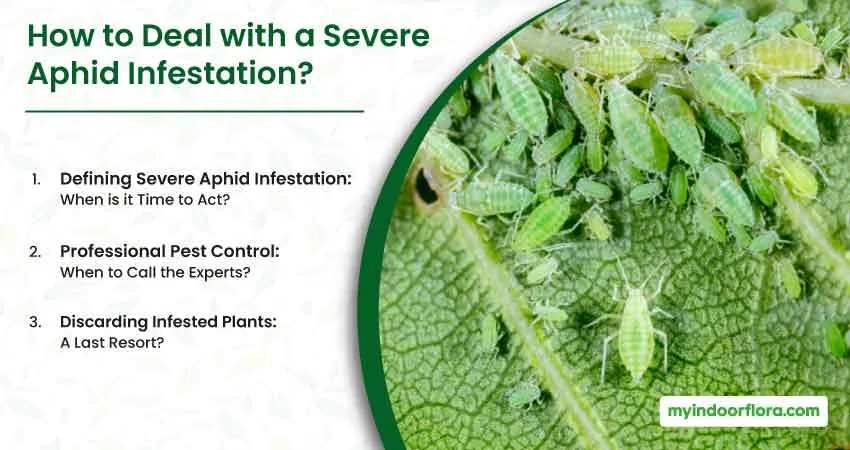
Managing a severe aphid infestation can be stressful, but knowing when and how to escalate your efforts can be the key to safeguarding your indoor garden.
Defining Severe Aphid Infestation: When is it Time to Act?
A severe aphid infestation is typically characterized by large aphid populations that are causing significant plant damage and are resistant to natural control methods. According to the University of California’s Integrated Pest Management Program, when aphid numbers are high and plant health is declining despite initial control efforts, you’re likely dealing with a severe infestation.
In addition to visible aphid populations and plant damage, other signs of a severe infestation may include the presence of numerous ants (which are attracted to the honeydew produced by aphids), widespread sooty mold growth, and the development of diseases transmitted by aphids.
Professional Pest Control: When to Call the Experts?
When aphid populations persist despite your best efforts, it might be time to consider professional pest control. Pest management professionals are equipped with a wide range of tools and techniques that can effectively handle severe aphid infestations.
A report from the National Pest Management Association (NPMA) suggests that professional pest control can provide benefits such as targeted and effective treatment, prevention of future infestations, and minimal risk to non-target organisms.
Before hiring a professional, ensure that they have a good understanding of integrated pest management (IPM), a holistic approach that combines biological, cultural, physical, and chemical tools in a way that minimizes economic, health, and environmental risks.
Discarding Infested Plants: A Last Resort?
In some situations, discarding heavily infested plants can be the most effective way to protect the rest of your indoor garden. While this can be a difficult decision, especially for rare or sentimental plants, it can prevent the spread of aphids to other plants.
According to a study published in the Journal of Applied Entomology, aphids can reproduce rapidly and move between plants, potentially leading to widespread infestation. Removing and properly disposing of an infested plant can break the aphid’s life cycle and contain the problem.
Before discarding a plant, consider if it can be pruned or propagated. Removing infested sections might be enough to manage the problem, and propagating a new plant from a healthy section allows you to preserve the plant without the aphids.
However, always be cautious about re-introducing propagated plants or new plants into your indoor garden space. A quarantine period can help ensure that these plants are aphid-free before they come into contact with your other plants.
How Can You Monitor and Ensure that the Aphids Do Not Return?
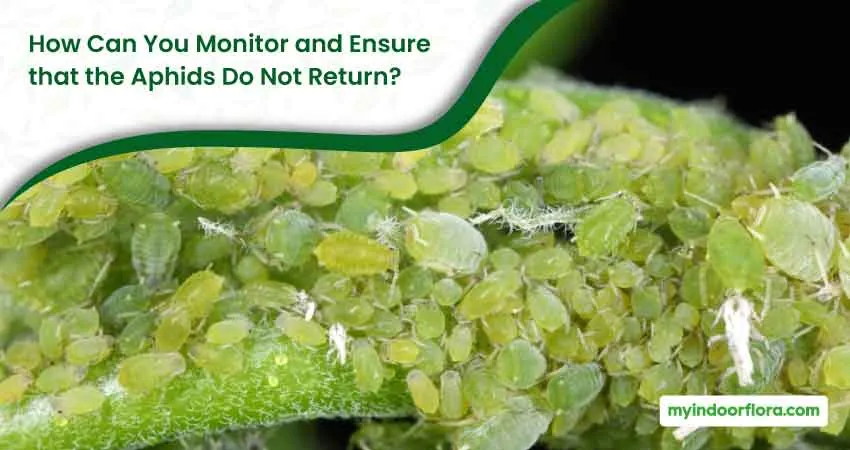
Once you’ve managed to control the infestation, regular monitoring and plant care are vital to ensure aphids do not return. Keeping your indoor garden healthy and maintaining cleanliness will help in the long term.
In conclusion, aphids, while small in size, can pose a significant threat to your indoor plants. Early detection and prevention can save your plants from these destructive pests. While chemical solutions are available, natural and homemade remedies are often just as effective and pose less risk to the environment. Remember, a healthy plant is your best defense against aphids.
Happy gardening!
